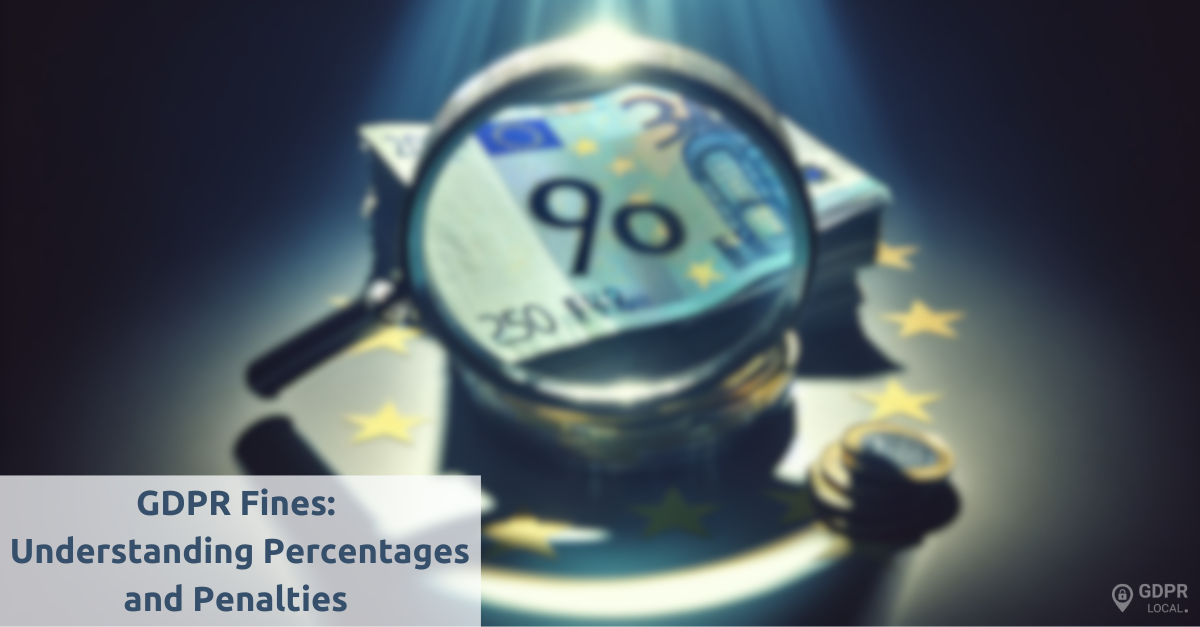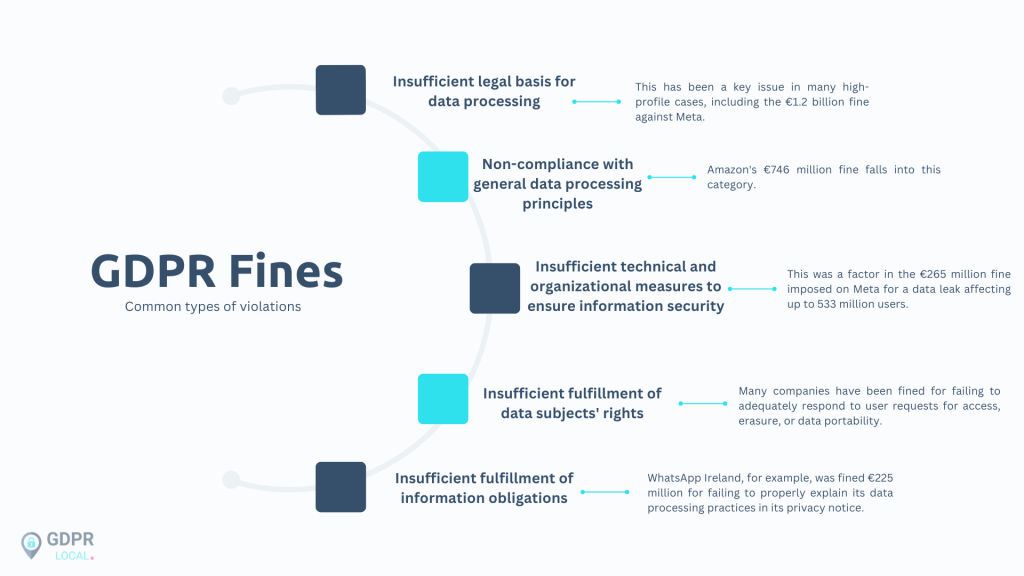
GDPR Fines: Understanding Percentages and Penalties
We take data protection seriously, and GDPR fines are a crucial aspect of enforcing compliance. These penalties have reshaped the landscape of data privacy, with recent GDPR fines reaching unprecedented levels. Our expertise in this field allows us to guide you through the complexities of these regulations, helping you understand the potential consequences of non-compliance and how to avoid them.
In this article, we’ll break down the structure of GDPR fines, explore the factors that influence penalties, and look at some notable cases, including the highest fine for data breach to date. We’ll also dive into the role of regulators like the ICO in imposing GDPR fines and provide insights on how businesses can stay compliant. By the end, you’ll have a clear picture of what’s at stake and how to protect your organization in this ever-evolving regulatory environment.
The Two-Tiered Structure of GDPR Fines
We understand that GDPR fines can be a complex topic, but we’re here to break it down for you. The General Data Protection Regulation (GDPR) has put in place a two-tiered system of fines to ensure companies take data protection seriously. This structure allows for different levels of penalties based on the severity of the violation.
Lower tier fines: Up to €10 million or 2% of global turnover
The lower tier of GDPR fines applies to less severe infringements. These fines can go up to €10 million or 2% of the company’s global annual turnover from the previous financial year, whichever is higher. This tier covers violations related to:
- Controllers and processors (Articles 8, 11, 25-39, 42, and 43)
- Certification bodies (Articles 42 and 43)
- Monitoring bodies (Article 41)
These fines are typically imposed for technical violations or failures to meet certain administrative requirements. For example, a company might face a lower tier fine for not properly documenting their data processing activities or failing to appoint a data protection officer when required.
Higher tier fines: Up to €20 million or 4% of global turnover
The higher tier of GDPR fines is reserved for more serious infringements that go against the core principles of data privacy and protection. These fines can reach up to €20 million or 4% of the company’s global annual turnover from the previous financial year, whichever is higher. This tier covers violations related to:
- Basic principles of data processing (Articles 5, 6, and 9)
- Conditions for consent (Article 7)
- Data subjects’ rights (Articles 12-22)
- Transfer of data to international organizations or third countries (Articles 44-49)
Higher tier fines are imposed for violations that directly impact individuals’ rights and freedoms, such as processing personal data without a lawful basis or infringing on data subjects’ rights.
Examples of violations for each tier
To help you understand the difference between the two tiers, let’s look at some examples:
Lower tier violations (2% or €10 million):
– Collecting personal data of children without parental consent
– Failing to maintain records of data processing activities
– Not notifying authorities or users about a data breach
– Neglecting to perform a data protection impact assessment
Higher tier violations (4% or €20 million):
– Processing personal data without a legitimate purpose
– Failing to obtain proper consent for data processing
– Not respecting data subjects’ rights (e.g., right to erasure)
– Transferring personal data to a third country without adequate safeguards
It’s crucial to note that these fines are not just theoretical. Recent GDPR fines have reached unprecedented levels, with some of the highest fines for data breaches making headlines. For instance, in 2023, Meta received a staggering fine of €1.2 billion from the Irish Data Protection Commission for transferring personal data of European users to the United States without adequate protection mechanisms.
We want to emphasize that the goal of these fines isn’t just to punish companies. They’re designed to encourage businesses to take data protection seriously and implement robust measures to safeguard personal information. By understanding this two-tiered structure, you can better assess the potential risks and ensure your organization stays compliant with GDPR regulations.
Factors Considered When Determining GDPR Fines
We understand that determining GDPR fines is a complex process that involves careful consideration of various factors. The regulatory authorities aim to ensure that the fines are effective, proportionate, and dissuasive in each case. Let’s delve into the key factors that influence the calculation of GDPR fines.
Nature and gravity of the infringement
The nature and gravity of the infringement play a crucial role in determining the fine amount. We take into account the specific circumstances of each case, including the type of violation and its impact on data subjects. For instance, a massive data breach that exposes sensitive personal information of thousands of users is likely to result in a higher fine compared to a minor violation with limited consequences.
The scope and purpose of the processing also factor into the assessment. If the infringement involves systematic and extensive profiling of data subjects or if it’s central to a company’s core business activities, it may be considered more severe. Additionally, we consider the number of affected individuals and the level of damage they’ve suffered, which can include physical, material, or non-material harm.
Intentional or negligent character
We also evaluate whether the infringement was intentional or resulted from negligence. Intentional violations, where a company knowingly disregarded the law, are typically viewed more seriously and may lead to higher fines. For example, if senior management authorized unlawful processing despite being aware of the risks, it would be considered an intentional infringement.
Negligent infringements, while potentially less severe, can still result in significant fines. These might include cases where a company failed to implement adequate data protection policies or neglected to provide proper training to employees handling personal data.
Actions taken to mitigate damage
We give due consideration to any actions taken by the data controller or processor to mitigate the damage suffered by data subjects. Swift and effective measures to contain a breach, notify affected individuals, and minimize harm can potentially reduce the amount of the fine. This factor underscores the importance of having a robust data breach response plan in place.
For instance, if a company promptly notifies affected individuals, offers support services, and implements additional security measures to prevent future incidents, we may view this favorably when determining the fine amount.
Previous infringements and compliance history
A company’s track record of compliance with GDPR is another critical factor in our assessment. Previous infringements, especially those related to similar issues or occurring recently, are likely to be considered as aggravating factors. Repeated violations may indicate a lax attitude towards data protection and could result in higher fines.
It’s important to note that the absence of previous infringements is not considered a mitigating factor, as compliance with GDPR is expected to be the norm. We expect organizations to demonstrate ongoing commitment to data protection and to take proactive measures to ensure compliance.
In conclusion, determining GDPR fines is a nuanced process that takes into account multiple factors. By understanding these considerations, organizations can better appreciate the importance of robust data protection practices and the potential consequences of non-compliance. Remember, the goal of GDPR fines is not just to penalize but to encourage a culture of data protection and respect for individual privacy rights.
Notable GDPR Fine Cases and Statistics
We’ve seen some eye-opening cases of GDPR fines in recent years, and I’d like to share some of the most notable ones with you. These fines have reshaped the landscape of data protection and serve as a stark reminder of the importance of compliance.
Largest GDPR fines to date
The largest GDPR fine to date was imposed on Meta Platforms Ireland Limited in May 2023. The Irish Data Protection Commission slapped the tech giant with a staggering €1.2 billion fine for transferring personal data of European users to the United States without adequate protection mechanisms. This fine alone nearly matches the total of all GDPR fines issued by January 28, 2022, which stood at approximately €1.64 billion.
Another notable case involves Amazon Europe Core S.à.r.l., which received a €746 million fine from the Luxembourg National Commission for Data Protection in July 2021. This fine resulted from a complaint filed by 10,000 people through a French privacy rights group, highlighting issues with Amazon’s advertising targeting system.
Trends in fine amounts over time
We’ve noticed a clear trend of increasing fine amounts over time. In the early days of GDPR enforcement, fines were relatively modest. However, as data protection authorities have become more confident in their enforcement roles, we’ve seen a significant uptick in both the frequency and size of fines.
In 2018, German chat app Knuddels faced one of the first GDPR fines, amounting to just €20,000, after a security breach exposed the personal data of 300,000 users.
This trend shows that authorities are taking GDPR violations increasingly seriously and are willing to impose substantial penalties to ensure compliance.
Most common types of violations resulting in fines
From our analysis of GDPR fines, we’ve identified several common types of violations that frequently result in penalties:

These trends in GDPR fines highlight the need for organizations to take data protection seriously. As we move forward, we expect to see continued enforcement action, with potentially even larger fines for severe violations. It’s clear that data protection authorities are sending a strong message: compliance with GDPR is not optional, and the consequences of non-compliance can be severe.
Conclusion
The landscape of data protection has been significantly reshaped by GDPR fines, with recent penalties reaching unprecedented levels. These fines serve as a wake-up call for organizations, highlighting the critical need to prioritize data privacy and security. The two-tiered structure of GDPR fines, along with the various factors considered in determining penalties, underscores the complexity of compliance and the potential consequences of falling short.
As we’ve seen from notable cases, the financial impact of GDPR violations can be substantial, with fines running into hundreds of millions or even billions of euros. This trend of increasing fine amounts over time sends a clear message: data protection is not just a legal requirement but a fundamental responsibility. To stay ahead of the curve, companies must continually assess their data practices, invest in robust security measures, and foster a culture of privacy awareness throughout their organizations.
For more information about GDPR compliance, contact us at [email protected].
FAQs
What are the maximum penalties under GDPR?
Under the General Data Protection Regulation (GDPR), the highest penalties can reach up to €20 million, or 4% of the annual worldwide turnover from the previous fiscal year, depending on which amount is greater. This applies to the most severe breaches of the regulations.
How is the amount of a GDPR fine determined?
The calculation of GDPR fines is primarily based on the severity and nature of the infringement. Authorities can impose fines up to €20 million or, for larger entities such as corporate groups, up to 4% of their total global turnover from the previous financial year, whichever is higher.
What consequences exist for violating GDPR rules?
Violations of GDPR can lead to substantial fines, with the most severe penalties reaching up to £17.5 million or 4% of the annual global turnover, whichever is greater. The enforcement approach is risk-based, focusing on the most serious breaches of data protection principles.
What are some of the largest fines imposed under GDPR?
Some of the highest GDPR fines recorded include a €1.2 billion fine for Meta, €746 million for Amazon, and other significant fines for companies like TikTok and Uber, ranging from €345 million to €290 million. Other notable fines include €265 million for Meta and €225 million for WhatsApp.